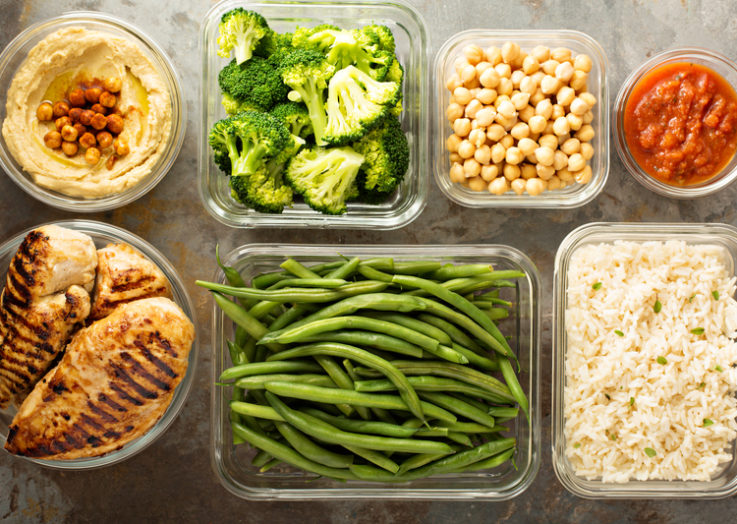To carb or not to carb, that seems to be the question. Some diets restrict (or control) carbs, others all but eliminate them (save for some non-starchy vegetables), and others embrace most carbs fully. No macronutrient is all “good” or all “bad,” though some sub-types may be vastly superior, and of course, the “vehicles” in which those macronutrients are packaged may tell a more important story. Rather than vilifying any macronutrient—be it carbs, fat, or protein—it may be more discovering a personalized approach that fits your goals, your body, and your lifestyle.
Some people clearly do better with a lower-carb diet (although what constitutes a “low-carb” diet is a bit of moving target), while others do better with more. Even more, many find they do best with both—depending on the day. That is to say that many find the “sweet spot” approach involves “cycling” their carbs. What does that mean? Let’s take a look at a carb cycling diet.
Carb Cycling Diet: What Is It?
A carb cycling diet is pretty much exactly what it sounds like: Rather than consistently eating the same amount of carbs, day in and day out, you intentionally vary your carb intake on a daily (even within days) or weekly basis. That is, some days are low-carb, some days are higher-carb, and some days are somewhere in the middle.
Many folks are discovering carb cycling allows them to “have their cake and eat it too,” or rather, have their cake and lose weight. 1 Meanwhile, some find that a carb cycling diet helps boost performance, especially when it comes to endurance. 2,3
In general, a carb cycling diet thoughtfully fluctuates carb intake so you get more when you “need” them (such as on days that you’re more active) and limits them when you don’t (such as on “rest” days or days when your activity level is lighter).
And it’s nothing new. In fact, it’s been a popular approach for bodybuilders, physique competitors, fitness models, and athletes (e.g., weight-class athletes) for decades.
How to Cycle Carbs
There’s a number of ways you can adapt the carb-cycling diet to fit your own needs. For example,
- Reduce carbs on most days when trying to drop body fat; have more higher-carb days when trying to gain muscle or strength (but still bake in one or two low-carb days, which may help mitigate unwanted fat gain).
- Add in more moderate- to higher-carb days once you’ve dropped to a certain level of body fat.
- Consume more carbs on days when you work out longer or harder and reduce carbs on those days when you work out less or have a rest day.
- Indulge in a higher-carb day (i.e., cheat day, diet break, scheduled refeed) during a strict diet to help improve the functioning of leptin and ghrelin, two key appetite- and weight-regulating hormones, improve metabolic flexibility, help support a metabolism, and perhaps most importantly, give yourself an often-helpful mental break (from the rigors of restriction).
- For within-day carb-cycling, consume more carbs after intense training to help boost recovery. 4
Again, how carbs are cycled depends greatly on personal goals. For example, is your top priority dropping body fat or boosting performance?
A Simple Carb Cycling Diet Plan
If all that sounds a bit overwhelming, you can start with a fairly simple approach where you eat lower carbs for three days, for example, followed by consuming moderate carbs for two days, with two high-carb days during the week. Or, eat low carb for two days followed by a higher carb day on the third. Or eat low carb for five days followed by two days of high-carb refeeding days.
- Day 1: Low-Carb
- Day 2: Low-Carb
- Day 3: High-Carb
- Day 4: Low-Carb
- Day 5: Low-Carb
- Day 6: High-Carb
- Day 7: Cheat Day
Carb cycling can also be an advanced strategy that takes a good deal of manipulation to ensure the proper amounts of macronutrients to accommodate training schedules and activity levels.
For most people, the low-carb day serves as the “baseline” or “foundation.” Let’s illustrate what I mean.
On low-carb days, you’ll focus on eating foods that provide healthy fats and protein as well as non-starchy vegetables (such as dark, leafy greens, cruciferous vegetables, etc.). On moderate- and higher-carb days, you’ll add starchy vegetables (e.g., potatoes), fruits, whole grains, and legumes to your low-carb menu.
No matter if it’s a high-carb or low-carb day, you’ll still want to put the emphasis on eating real, whole, minimally processed foods while avoiding refined carbs (e.g., refined flour, added sugar), like white bread, cookies, soda, and sugary snacks, and refined vegetable/seed oils (e.g., soybean, canola, corn, safflower, sunflower, and cottonseed oils).
What does it mean to eat high carb, moderate carb, vs. low carb? There are no clear-cut boundaries, but they typically look something like this:
- High: 70+%
- Moderate: 45 – 65%
- Low: up to 25% carbs
Will a Carb Cycling Diet Help You Lose Weight?
You know what’s coming… it depends. In theory and in practice for many people, it can be quite effective. In addition, it’s been shown to also be helpful for folks who are trying to lose weight while maintaining performance.
But that doesn’t mean it’s right for everyone, and the usual weight-loss caveats—like ensuring you’re in an energy/calorie deficit, on average (not necessarily every day)—still apply. Perhaps one of the biggest benefits is that it’s easier to stay on track with a low-carb diet when you know you can occasionally indulge in a high-carb meal, and that tends to lead to greater compliance over the long haul.
Of course, while we’re talking about carbs, the fact of the matter is that we eat food—not carbs. Along those lines, eating the right types of foods is still important. You’ll want to stick with those that are minimally processed and nutrient dense rather than eating a bunch of sweets.
Other potential benefits of a carb-cycling diet include helping build or preserve muscle mass, particularly when “dieting” for fat loss. In addition, the low-carb days of carb cycling diets may help improve insulin sensitivity, 5 increase fat burning, and enhance metabolic health, 6 while the high-carb meals or days may positively affect appetite and weight-regulating hormones including leptin, thyroid, and even testosterone.
Of course, with any diet change, you can expect your body to take some time to adjust. If you start a carb cycling diet, you may feel more tired than usual or weaker during workouts, and you may find yourself craving carbs, especially on low-carb days. You may also find it more difficult to fall asleep or that it affects your mood. You could even experience bloating, constipation, or water retention, especially after higher-carb days. After a couple of weeks, you’ll likely know if this diet style is or isn’t a good fit for you. Again, with any diet, remember to listen to your body and respond to how you feel.
Because a carb cycling diet is so flexible, many people find it’s exactly what they need to accelerate weight-loss progress and improve performance. This type of approach, which some might call “periodized nutrition” or “intermittent carbohydrate restriction,” seems to help preserve metabolic rate (metabolic rate often drops significantly when restricting calories, spare calorie-burning lean muscle, and allows for an indulgence from time to time, which tends to improve compliance and results (in the short- and long-term).









